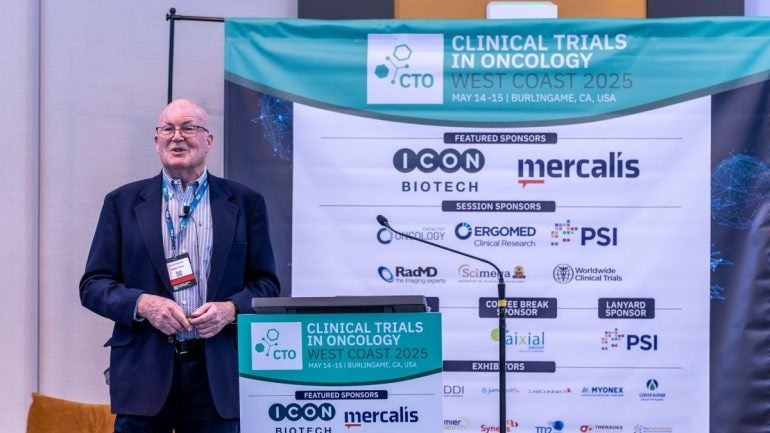Feature
Policy changes and digital strategies guide oncology research
Irena Maragkou outlines how experts discussed the future of oncology clinical trials and key themes surrounding them at the CTO West Coast conference.

David Larwood, CEO of Valley Fever Solutions was one of the experts that discussed the future of oncology trials and policy changes that impact them. Credit: Athanasios Psimadis / Arena International Events
Aagainst the backdrop of the recent US Food and Drug Administration’s (FDA) staff cuts and administrative realignment, understanding accelerated approval regulatory pathways, implementing pragmatic approaches and digital solutions is becoming more significant in the oncology clinical trial space.
Last month, executives from biopharmaceutical companies, clinicians, and clinical trial experts in the field of oncology gathered at the 15th Annual Clinical Trial in Oncology West Coast (CTO) conference to discuss the latest challenges and trends that will shape the future of oncology trials. The meeting took place on 14-15 May in Burlingame, California.
According to Tatiana Kolesnikova, Director of Oncology at GlobalData Healthcare, opportunities for research and development in oncology persist, although increasingly in less obvious cancer types. Hundreds of cell therapies for oncology are currently in development, with projections estimating they will generate over $28bn by 2031.
Reflecting this momentum, industry leaders gathered at CTO West Coast to discuss the impact of recent directives, with a focus on advancing innovation through topics such as trial decarbonisation and the adoption of pragmatic strategies that are becoming essential for clinical trial success in oncology.
Latest policies on oncology trials
David Larwood, CEO of Valley Fever Solutions, said FDA guidance documents, are critical to convey regulatory expectations on trial design and endpoints. The FDA’s accelerated review pathway is intended for serious or life-threatening conditions, particularly when there is an unmet need. These pathways are especially relevant in oncology, where the urgency of treatment and the long duration of traditional trials make faster approval pathways significant, he said. Instead of waiting years for survival data, surrogate endpoints like tumour shrinkage can be used to demonstrate early signs of efficacy, allowing promising therapies to reach patients more quickly, Larwood highlighted.
With regards to the evolving regulatory landscape and administrative changes, Larwood said the FDA has gradually added regulatory layers in response to past health crises, creating a framework of guidance and review. With each new administration, including the current one, leadership changes, such as the head of the Center for Biologics (CBER), often bring shifts in policy, he said. Dr. Vinay Prasad was appointed on 6 May to head the CBER under the FDA, after the high profile resignation of Dr. Peter Marks, who previously held the post.
However, Larwood said changes take time to implement, and as of now, no new directives have yet been released under the current administration. Changes in policy take time to roll out, and “we are fairly into the new regime,” he said. In January 2025, guidance on oncology trials, endpoints, and evaluation of oncology drugs was published under the previous administration, while the last formal guidance on clinical trial endpoints is from 2018. Thus, this creates a period of uncertainty as the industry awaits updated regulatory direction, he concluded.
Digital solutions to transform clinical decision-making in oncology
Another overarching theme discussed across multiple sessions at CTO West Coast was the impact of digital solutions, artificial intelligence (AI) and wearables, as well as the implementation of patient-centric approaches in oncology trials.
AI’s greatest impact could come from improving trial success rates by ensuring therapies are tested in the populations most likely to benefit, said Steve Warner, Senior Vice President and Head of Translational Research & Medicine and Oncology at Sumitomo Pharma America. Warner outlined the real-world uses of AI within his company, explaining that it enables Sumitomo to manage vast and expanding datasets, pinpoint the appropriate patient populations, and tailor trials to meet their needs.
He noted that Sumitomo has begun exploring the use of digital twins, using preclinical and clinical data to simulate trials. Sumitomo Pharma has begun integrating AI in early clinical development by combining clinical trial data—like efficacy, pharmacokinetics, and patient-level information— with preclinical data from animal model studies and drug interaction profiles. This comprehensive dataset is fed into AI models, enabling them to “construct digital twins for each patient in the study—or even theoretical future patients. That allows us to run simulations and explore specific clinical scenarios,” Warner said.

Hundreds of cell therapies for oncology are currently in development, with projections estimating they will generate over $28bn by 2031. Credit: sanjeri / Getty Images
Sumitomo is in a unique situation to test this approach in myelofibrosis because the total symptom score has been a regulatory endpoint for new agents in myelofibrosis, as per Warner. Most oncology studies are more focused on survival or quality of life measures, which can be challenging to validate with regulatory agencies. While still in an exploratory phase, Warner views this as a valuable test case to explore whether digital twin simulations can provide insights into a compound’s impact on symptom burden and quality of life, and if it may have potential for broader application across other tumor types or patient populations, he concluded.
The topic of wearables was also addressed across multiple panels, but whether wearable data can provide a push for novel regulatory endpoints is still under debate. Jennifer Willert, Global Clinical Development Medical Director, Novartis Cell and Gene/Hematology, raised important ethical and logistical considerations with the use of wearables. Given concerns about privacy and data collection, Willert advocated for transparency and having clear boundaries in data handling. New regulations mandate that patients receive accessible summaries of clinical trial results, a step toward greater transparency, said Willert, adding that she supports sharing insights with patients even earlier in the trial process.
Potential implications of “most favored nation” executive order and IRA
There are significant policy and ethical considerations surrounding the drug pricing, and access to oncology drugs. During a panel on accelerated approval pathways for oncology drugs, Larwood said pricing policies such as Trump’s most favored nation (MFN) executive order, which aims to prevent Americans from paying more for drugs than patients in other countries, could potentially lower costs, but also affect drug development strategies.
Many governments use price controls to limit how much they pay for drugs, which has made essential medicines, like HIV treatments, widely accessible in lower-income regions such as Africa, said Larwood. However, although this approach supports public health goals and ensures accessibility, it is making it difficult for pharmaceutical companies to recover the substantial costs involved in drug development, he noted. In Europe, strict price controls have undermined profitability, and consequently many companies have reduced their investment in new drug research, which has led to fewer new medicines being developed, he said.
Prior to MFN, the Inflation Reduction Act (IRA) also introduced government-imposed pricing negotiations on certain drugs. While the long-term effects are still unfolding, there is widespread concern that these policies could reduce the incentives for drug companies to innovate and bring new treatments to market. Larwood noted that a potential reduction in innovation and drug availability, might not be apparent immediately but could affect future generations as it “may not really be felt for five to ten years. But when the people who are 50 years old now are getting older and they don’t have any drugs anymore, they’ll say, what could we have done differently?”.